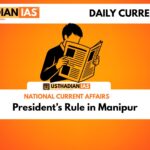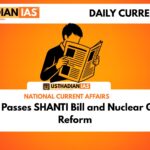India’s Constitutional Balance
India’s Federal Balance Under Strain: India’s Constitution envisions a quasi-federal structure — a unique model combining both federal and unitary characteristics. This structure ensures a strong national framework while preserving the autonomy of states. The idea is rooted in the concept of “self-rule with shared-rule”, forming the foundation of India’s democratic functioning.
Static GK fact: The term “Union of States” was deliberately chosen in Article 1 to signify India’s indestructible unity.
Federal Features of the Constitution
India’s Written Constitution establishes a clear division of powers between the Union and States. The Dual Polity structure allows both levels of government to function independently within their jurisdictions. Through Bicameralism, the Rajya Sabha represents the interests of states, providing balance against potential majoritarian decisions in the Lok Sabha.
The Seventh Schedule defines powers through the Union List, State List, and Concurrent List. This systematic distribution is supported by constitutional mechanisms ensuring smooth governance across different levels.
Static GK Tip: The Government of India Act, 1935 served as the blueprint for India’s federal system and the three-fold distribution of powers.
Unitary Features Strengthening the Centre
Despite its federal character, India retains unitary features to maintain national integrity. The strong central authority enables uniform decision-making, particularly in times of crisis. Articles like Article 3 empower Parliament to alter state boundaries and territories without state consent.
Uniform citizenship and integrated judiciary further solidify the centralized framework. Moreover, All India Services ensure administrative unity, while Emergency provisions (Articles 352–360) allow temporary concentration of power in the Union to safeguard sovereignty and stability.
Contemporary Challenges to Federalism
India’s quasi-federal balance faces multiple challenges today. Fiscal centralisation, especially after the implementation of GST, has reduced states’ financial autonomy. Similarly, administrative centralisation was evident during the COVID-19 pandemic, when the Disaster Management Act was invoked with minimal state consultation.
Governors reserving state bills for Presidential assent, delayed devolution of funds by Finance Commissions, and political dominance by the Centre have further strained relations.
Static GK fact: The Finance Commission, constituted every five years under Article 280, recommends the distribution of financial resources between the Centre and States.
Strengthening Cooperative Federalism
Institutions like the GST Council and NITI Aayog remain vital for maintaining cooperative federalism. These platforms foster dialogue and ensure policy synchronization across the nation. The spirit of “Team India”, championed by NITI Aayog, reflects an evolving partnership where both Centre and States work as equal stakeholders in development.
To sustain India’s federal harmony, there is a need for dynamic balance — one that promotes unity without compromising regional autonomy.
Static Usthadian Current Affairs Table
India’s Federal Balance Under Strain:
| Topic | Detail |
| Type of Government | Quasi-federal system combining federal and unitary traits |
| Article Defining India | Article 1 – “India, that is Bharat, shall be a Union of States” |
| Constitutional Basis for Division of Powers | Seventh Schedule (Union, State, and Concurrent Lists) |
| Article Empowering Parliament to Alter State Boundaries | Article 3 |
| Key Federal Institutions | GST Council, NITI Aayog, Rajya Sabha |
| Fiscal Authority Division | Determined by Finance Commission under Article 280 |
| Example of Fiscal Centralisation | Implementation of GST |
| Example of Administrative Centralisation | Use of Disaster Management Act during COVID-19 lockdown |
| Key Unitary Features | Single citizenship, integrated judiciary, emergency powers |
| Concept Promoting Balance | Cooperative federalism through Team India approach |








